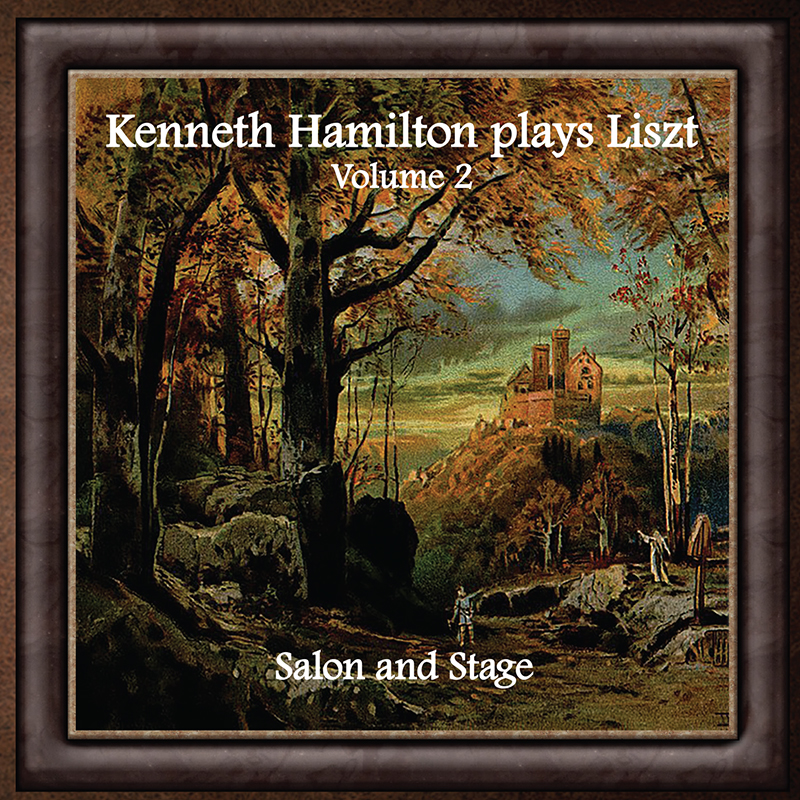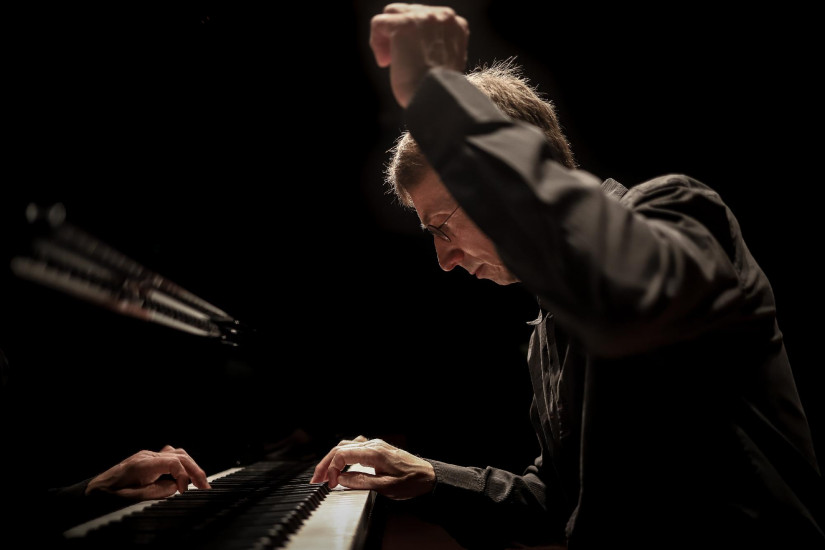A student of Franz Liszt at a distance of 150 years
Pianist and Liszt researcher Kenneth Hamilton, author of the best-selling book After the Golden Age, gave a matinee concert in the Liszt Museum in June. We talked about the Liszt tradition, about the appreciation of transcriptions and paraphrases, and Hamilton’s recent album, launched at the Liszt Museum.
Hanna Jereb: You've been to Budapest many times, how does it feel to come back? How do you feel about the Liszt Academy?
Kenneth Hamilton: Budapest is a wonderful city, it's fantastic to return here. On the one hand, the cityscape with the Danube and the Buda Castle is one of the most beautiful in the world. I consider it comparable to the Hellespont or the Golden Gate. To walk through Budapest's stunning 19th century buildings is like stepping back in time to the Habsburg Empire – in a more modern and cleaner version. On the other hand, playing Liszt's works in the concert hall of the Old Academy of Music, next to the composer's former salon, is a great experience. You can almost feel his presence, it's easy to imagine him coming and going. And the room is very suitable for piano concerts, thanks to its small size and intimate atmosphere. I also love to play on the podium of large concert halls with many seats, but I have very little contact with the audience, as the people are often hidden from view by the stage lighting. It must also be remembered that almost all of the 19th century repertoire was not written for large concert halls and modern instruments, but for more intimate settings, and most of these works therefore require intimacy.
HJ: In addition to the concert, the purpose of your visit is to present your new CD. Could you summarise the concept?
KH: I am interested in recordings with concepts and themes. The basic idea behind the Death and Transfiguration album of my CD series (Kenneth Hamilton Plays Liszt – ed.) is that I have chosen themes that correspond to Romantic ideals, such as love, death and desire. Instead of simply recording a series of poetic and religious harmonies, I wanted to offer a musical narrative. For example, I recorded the pieces in the series in a different order than they appear in the score, because I wanted to establish new connections between the works that open up previously unknown perspectives for the listener. I find particularly exciting the way in which religious images and characters are combined with the theme of love in this series. The concept of the second volume, Salon and Stage, which has just been released, is more complex. It features Liszt transcriptions with contrast as a central element. However, the main connecting thread is the circle for whom the composer wrote these works: Hans von Bülow, Sophie Menter, Cosima, Marie d'Agoult, Eduard Lassen. The third, as yet unreleased album will contain Weihnachtsbaum and Années de pèlerinage III. The release will be titled From Whom the Bell Tolls, after a poem by John Donne, in reference to the thread that connects the pieces, the different bell sounds featuring in various works. A fourth album in the series is still in preparation. Its concept is to contrast demonic and religious elements through Liszt's works, a theme that is closely linked to the first disc.
Another element that ties the whole CD series together is that I am trying to play these works according to Liszt's tradition, somewhat in the way that Liszt, as a teacher, reportedly asked his students to do. I told a reviewer earlier that I try to consider myself a student of Franz Liszt– with 150 years of time travel. When you make a recording, especially of pieces that have been recorded hundreds of times before, you always have to ask yourself: why? You have to find a convincing artistic reason why you want to add to the mass of recordings, otherwise it is all in vain. My solution to this problem is to come up with some kind of concept so that I can justify to myself – and to others if necessary – the reason and purpose of the venture.

HJ: You mentioned the Lisztian legacy. Can we even talk about a continuous Liszt-tradition?
KH: I think that there is a tradition, even if we are not talking about a unified one, because great artists never play like each other. Most people realise that the famous Liszt students, for example Friedheim, Sauer, Bülow, all played differently. Fortunately for us, some of these students survived well into the 20th century, and left accounts of the composer’s teaching, and editions and recordings influenced by it. Lina Ramann’s Liszt Pädagogium, the reminiscences of August Stradal (1860-1930), and the diaries of August Göllerich (1859-1923) and Carl Lachmund (1853-1928) are especially valuable. Much more was passed down than sometimes thought. Liszt’s most gifted pupils received copious individual attention and detailed instruction outside of the famous “masterclasses”. This was especially true for those who, like Arthur Friedheim (1859-1932), Göllerich, Stradal and Bernhard Stavenhagen (1862-1914), sporadically took on roles as Liszt’s secretary, reader or amanuensis-- which became increasingly necessary as the composer’s eyesight and general health began drastically to decline after 1881. It is quite clear, if you look at the versions of Liszt's works that they wrote down, that each pupil adopted Liszt's ideas and alternative passages, and from August Göllerich's diary, for example, you can sometimes get a pretty good idea of how each pupil played. All these people had heard Liszt play and teach live, and despite their differences they often adopted a similar general style.
HJ: The concept of this CD, the transcription and paraphrase as a genre has changed a lot over the centuries. Liszt was undoubtedly a great transcriber, yet he was often criticised for it. Does this matter to a contemporary pianist who performs arrangements?
KH: I think these criticisms are outdated today. We are living in an artistically postmodern era, which is really just a fancy way of saying that we do what we feel is right. In a way, it’s almost a return tot he liberties of Romanticism.The negative perception of transcriptions (as opposed to original, independent compositions) started to grow at the end of the 19th century. There was a general feeling that it was a problem if one played too many transcriptions instead of original works. Busoni, for example, complained to his wife that he sometimes could not programme transcriptions in Germany because they were disapproved of by critics. This trend continued until the Second World War. The big breakthrough came with the Liszt Centenary in 1986, when performers began to play the complete oeuvre. I should add that Liszt's transcriptions have virtually never been negatively portrayed in reviews because of their quality. Even Brahms and Hanslick acknowledged Liszt's inimitable talent in this respect. In fact, Liszt’s fantasies and transcriptions were composed with such genuine creativity, and with such consummate command of pianistic effect (“the classicism of keyboard technique” according to Johannes Brahms) that they effectively constitute original works in their own right. Robert Schumann made that point long ago in a bedazzled review of Liszt’s first major transcription: his gargantuan version of Berlioz’s Symphonie Fantastique. In contrast to the reception of Liszt’s completely original pieces, which were castigated by most conservative critics, Liszt’s genius as supremely adept arranger for the keyboard was generally acknowledged from the outset. As an old man, he used to joke to his students: “You won’t have success with my original music – everyone knows I have no talent as a composer. But I do have some modest ability as a transcriber!” We simply had to rediscover these fantastic pieces,this genre. Today, an apposite response to the question of whether a work is a transcription or an original work is: does anyone really care?

HJ: The concert programme for the CD launch is very exciting. Can you tell us about the composition of this?
KH: Chorale melodies weave through this programme, and it begins and ends with pieces based on them. Even the Bach-Siloti Prelude features a chorale-like „accompanying voice”, added by Siloti himself. . I have also chosen Liszt's thrilling but little-known adaptation of music by Adalbert von Goldschmidt (Liebesszene und Fortunas Kugel aus dem Oratorium ʻDie sieben Todsündenʼ. Fantasiestück) – there are very few recordings of it, despite its fascinating features – and a nocturne by Chopin, which is in complete contrast to the other pieces. The final item in the programme is the Liszt-Busoni Fantasy and Fugue on the Chorale Ad nos, ad salutarem undam, undoubtedly one of the greatest pieces of 19th century piano literature. Playing this, or listening to it, has an absolutely overwhelming effect. It’s as wonderful as the Liszt b minor Sonata, although far less well-known, and if anything even more difficult to play. But the effort is certainly worth it!



